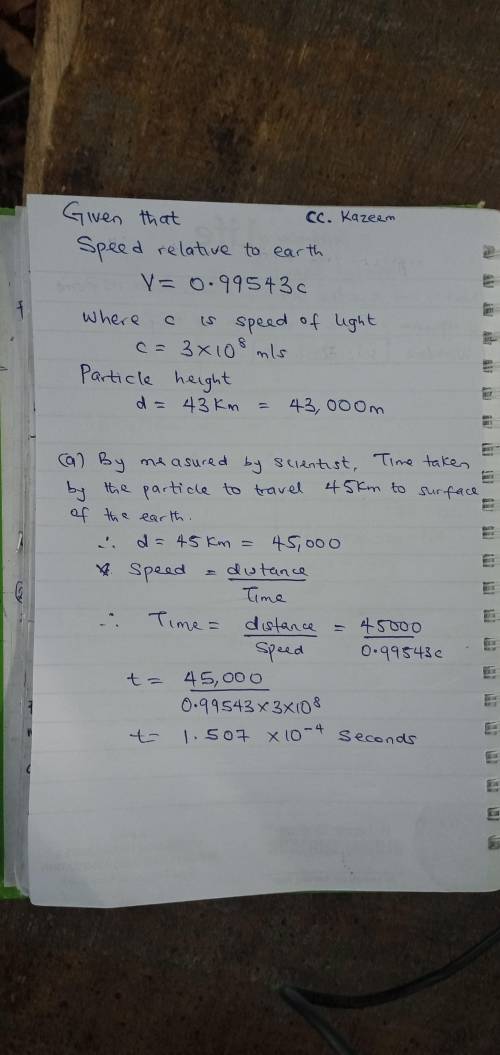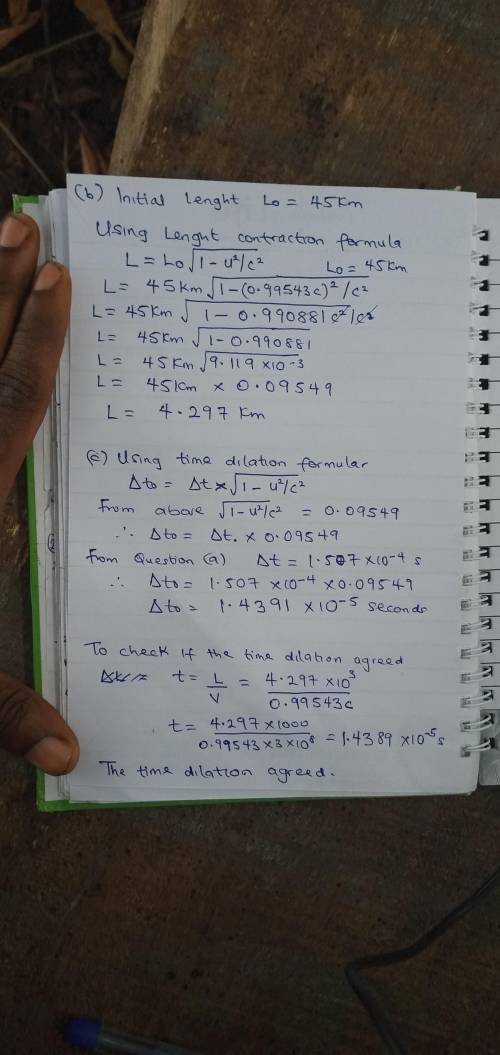
Physics, 21.04.2020 18:06 emmmssss21
An unstable particle is created in the upper atmosphere from a cosmic ray and travels straight down toward the surface of the earth with a speed of 0.99543c relative to the earth. A scientist at rest on the earth's surface measures that the particle is created at an altitude of 43.0 km .
(a) As measured by the scientist, how much time does it take the particle to travel the 45.0 km to the surface of the earth?
(b) Use the length-contraction formula to calculate the distance from where the particle is created to the surface of the earth as measured in the particle’s frame.
(c) In the particle’s frame, how much time does it take the particle to travel from where it is created to the surface of the earth? Calculate this time both by the time dilation formula and from the distance calculated in part (b). Do the two results agree?

Answers: 2


Another question on Physics

Physics, 22.06.2019 00:00
A1000-kg weather rocket is launched straight up. the rocket motor provides a constant acceleration for 16-s, then the motor stops. the rocket altitude 20-s after launch is 510-m. you can ignore any effects of air resistance. a. what was the rocket’s acceleration during the first 16-s? b. what is the rocket’s speed as it passes through a cloud 5100-m above the ground?
Answers: 1

Physics, 22.06.2019 10:30
Avery long solenoid of inner radius 2.75 cm creates an oscillating magnetic field of the form = for this solenoid, =0.00425 t and =319 rad/s. (a)what is the maximum value of the induced electric field at a perpendicular distance 1.45 cm from the axis of the solenoid? (b) what is the maximum value of the inducted electric field at a point 5.85 cm perpendicular from the axis of the solenoid?
Answers: 1

Physics, 22.06.2019 11:30
With the simplified model of the eye, what corrective lens (specified by focal length as measured in air) would be needed to enable a person underwater to focus an infinitely distant object? (be careful-the focal length of a lens underwater is not the same as in air! assume that the corrective lens has a refractive index of 1.62 and that the lens is used in eyeglasses, not goggles, so there is water on both sides of the lens. assume that the eyeglasses are 1.90
Answers: 1

Physics, 22.06.2019 18:30
Arailroad car collides with and sticks to an identical railroad car that is initially at rest. after the collision, the total kinetic energy of the two cars is a) the same as before. b) half as much as before. c) one third as much as before. d) one fourth as much as before. e) twice as much as before.
Answers: 1
You know the right answer?
An unstable particle is created in the upper atmosphere from a cosmic ray and travels straight down...
Questions

Mathematics, 23.08.2019 23:30

World Languages, 23.08.2019 23:30


English, 23.08.2019 23:30




English, 23.08.2019 23:30


Mathematics, 23.08.2019 23:30

English, 23.08.2019 23:30



History, 23.08.2019 23:30





Physics, 23.08.2019 23:30





